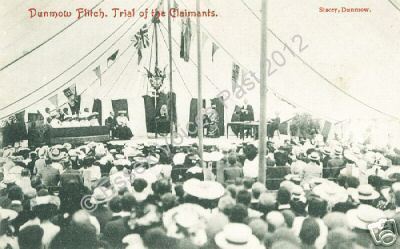
The strange custom of the Dunmow Flitch - dating from medieval England, it still takes place in the modern-day every leap-year. This postcard, from the early 1900s, shows the inside the court-room where the Judge hears the case for the bacon and the case for the claimants .
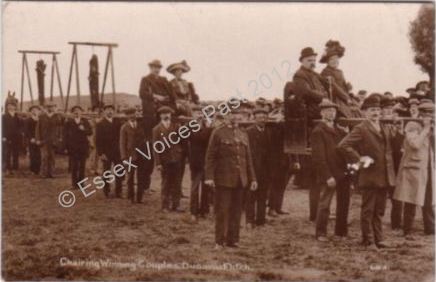
The Dunmow Flitch: Chairing the winning couples in the early 1900s.
I'm very pleased to have been invited to join this worldwide blogging project. I write a blog on local history at Essex Voices Past - my blog covers some aspects of local history regarding Essex, along with posts about the history and goings-on of the Tudor monarchs of England. I also write local history posts about the First World War and the soldiers from my town who marched away to war in a distant land, never to return.
For my first post on this blog, I thought I'd introduce myself to you and reflect back on my days of being a family historian and local historian.
I first started out as a family historian when I was 18 years old - back in the Dark Ages of the 1980s - prior to the invention of the internet. In those days, I traipsed through the streets of London to track down my ancestors using the Society of Genealogists' library (then in their original home in Kensington), the Public Record Office (then in Chancery Lane) and another reading room somewhere around Chancery Lane which housed all the microfiche readers for viewing the census. At that time only the censuses for 1841, 1851, 1861 and 1871 were available! I can remember the anxious wait by myself and my fellow researchers for the 1881 census to become available after the 100 year rule of non-disclosure expired (I seem to recall that 1980s "technology" meant that this census wasn't released 100 years on, in 1981, but we had to wait until a couple of years later). Births, marriages and deaths certificates were held in St Catherine's House on the Aldwych in London (affectionately known to my fellow researchers as "St K's house" - or am I remembering that wrongly, being that it should have been St C's house?). Massive books to be lugged out of their shelving racks to look for long dead ancestors - red for marriages, green for births and black for death - 4 per year. I'm sure my arm muscles got very well defined during this period in my life as I steamed through countless books trying to find ancestors hiding in those lofty, dusty, humongous volumes.
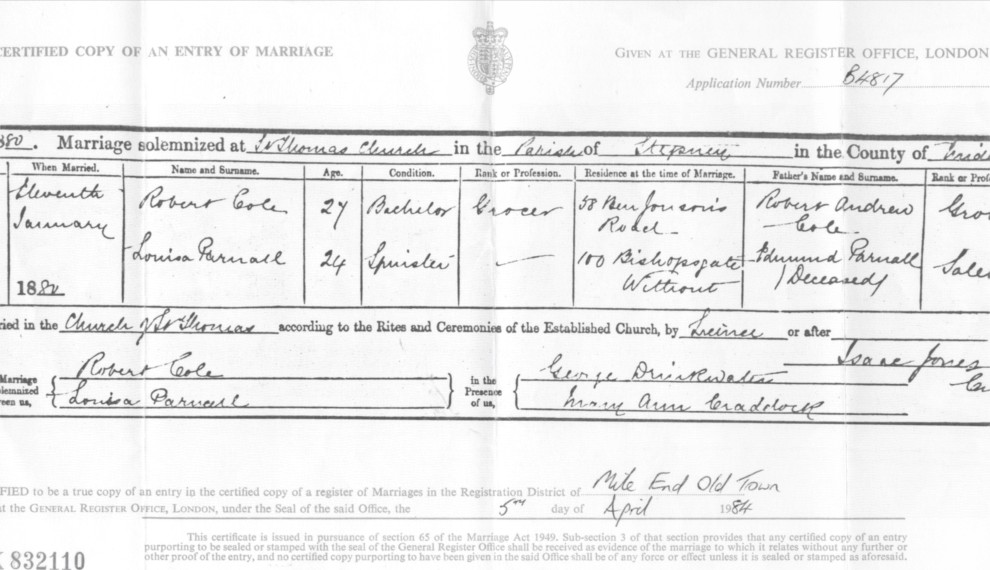
Marriage certificate of my great-grandparents: Robert Cole (1852-1927) to Louisa Parnall. The marriage certificate was bought in 1984 when the records for post-1837 births, marriages and deaths were kept at St Catherine's House in London. It is strange for me to realise that I bought this certificate 30 years ago.
During this early period of my research, I discovered that my paternal ancestors had all been born and bred in the eastend of London - true Londoners. Many had stayed in east London, whilst others migrated to the suburbs in south London and Essex. Fortunately I have many photographs of my paternal family in the eastend and south London. Over the coming months, I hope to be able to share some of those previously unpublished photos with you. I have already published some of these photos on my own blog, where I have written the story of my great-great grandparents, The Cole family of Spitalfield Market
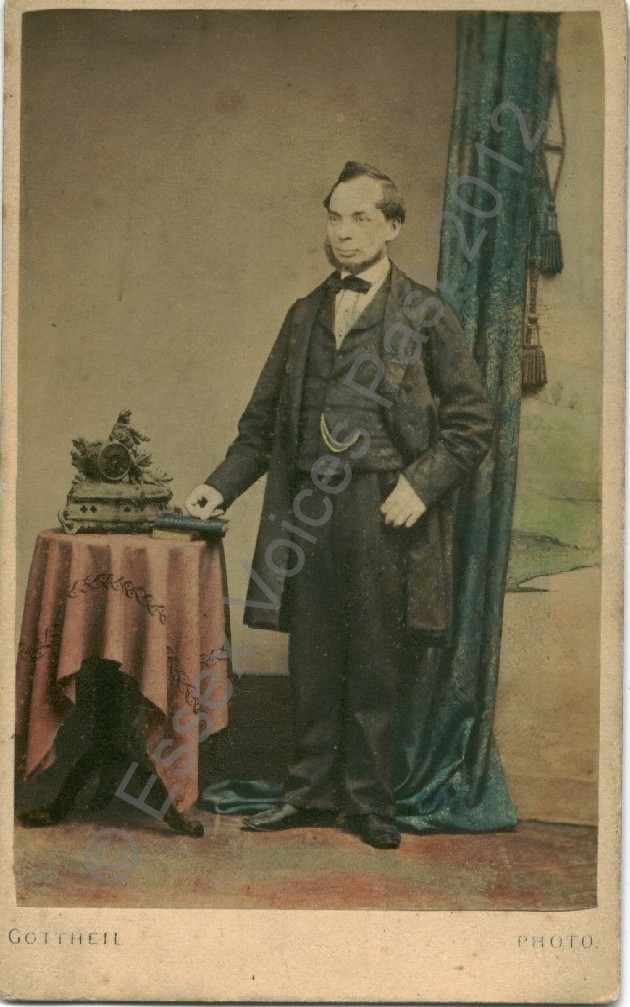
That was my research during the 1980s. I remember it as a very exciting period as I discovered each new link to my family tree and discovered my family's long connection to east London - stretching back into the mid-1700s. With the common name of "Cole" it was surprisingly much easier than I would ever have imagined to trace a pure eastend family back to the very heart of London's maritime past and into the docks of Shadwell.
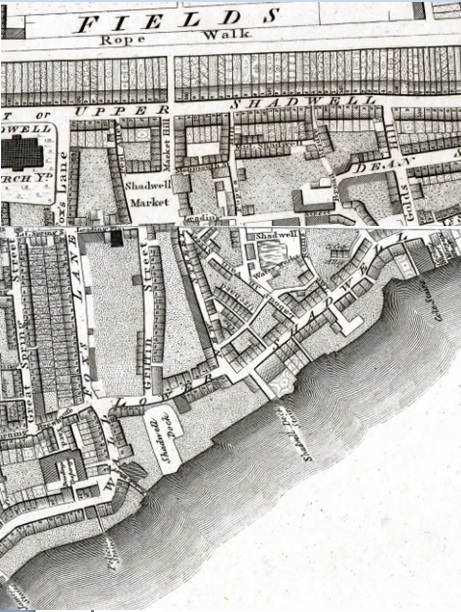
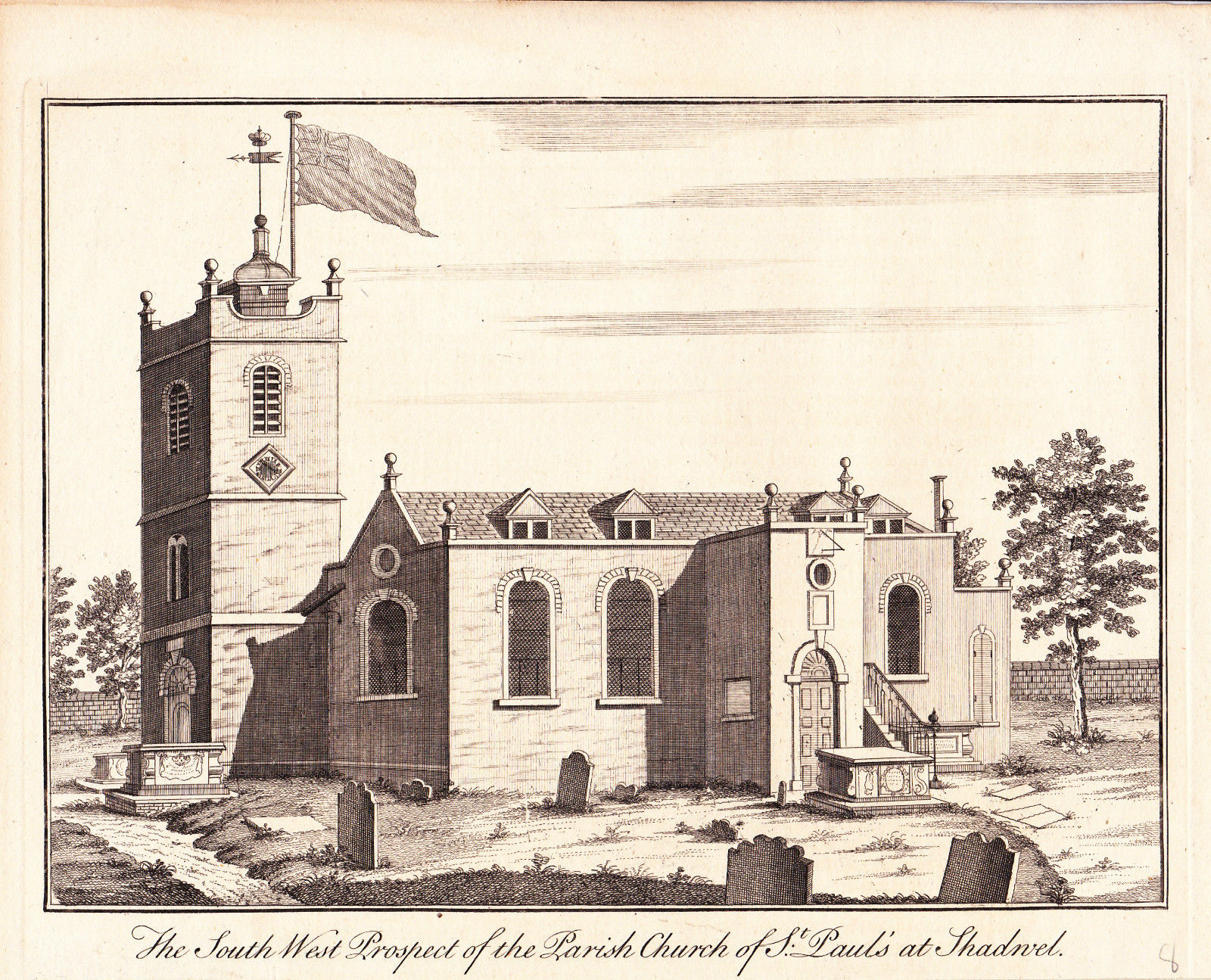
The church of St Paul's, Shadwell in the 1760s. It was known as the Church of the Sea Captains because of its links to the nearby docks and its churchyard contains the graves of at least 70 sea captains. It was the parish church of Captain James Cook and Thomas Jefferson's family. It was also the parish church of my ancestors, John and Catherine Cole, who baptised at least 8 of their children in the church in the 1770s and 1780s.
During the 1990s, my family history habit had to be put away whilst I brought up two small children as a single parent. Then, in 1999, on the eve of the millennium, I bought a new computer, signed up to the numerous genealogy sites which had to started to spring up, and within days made contact with a previously unknown 2nd cousin (at least, I think that's our relationship!). Barbara was living in Sydney, Australia. Her ancestors - my great-grandparents' siblings descendants (are you still following?) - having emigrated to Australia in the early decades of the 1900s. Much comparing of notes went on between her and I whilst we compared many many photos we each had. To our shock, we found that we actually had duplicates of the same photos! In other photos, by comparing notes, we were able to identify previously unknown people. Our comparing of family trees reached dizzying new heights when Barbara visited England and stayed with me in the early 2000s and we spent countless hours jointly pouring over photographs.
With one photo, the wedding of my great-grandparents, we originally thought we each had separate copies of the same photo, but quickly realised that we'd each actually got a slightly different photo. The photographer must have taken a number of shots on the "big day" and people had very slightly adjusted their poses between each photograph. Barbara only knew the photo as the "English wedding party" and could identify two sets of guests but not the bride and groom. Whilst I knew it to be the 1899 wedding of my great-grandparents, Lily Gurney to John Gurney, in Peckham, South London, and could also name other guests - John Gurney's sisters and other guests, including the woman who would ultimately become John's second wife (but more of that woman on a future post!).
Even more strangely, we worked out that this particular branch of our joint family married their own cousins - my great-grandparents (the bride and groom) being 1st cousins. The two sets of guests Barbara could name were the bride's brother and his wife (James Albert Gurney and Elizabeth Catherine Reed), and the grooms's brother and his wife (James Bloss Gurney and Caroline Mary Bint). Despite being 1st cousins to each other, these four people were all Barbara's great-grandparents because their children ultimately married each other (2nd cousins). It was a very confusing time as we worked out who had married who and when - particularly as we found other first cousins marrying each other, and the two families involved consisted of about 22 boys and girls - all with the same or similar names, and all living merely a few houses away from each other in Peckham! This was in the late Victorian era in the bustling respectable suburbs of busy south London - not in some rural quiet backwater where inter-marriage between cousins was more common-place. Lily's and James Alberts's father, James Swain Gurney, had been a highly respected south London publican who had also lived in Jersey and Australia; whilst John's and James Bloss's father, Henry Richard Gurney (brother to James Swain Gurney) had been a respected south London builder.
Are you sure you're still following?...I often need to lie down in a darkened room after working out the relationships of these Gurneys. I cannot tell you how many drafts of the previous paragraph I had to write until finally - I think - I've got all the relationships correct.
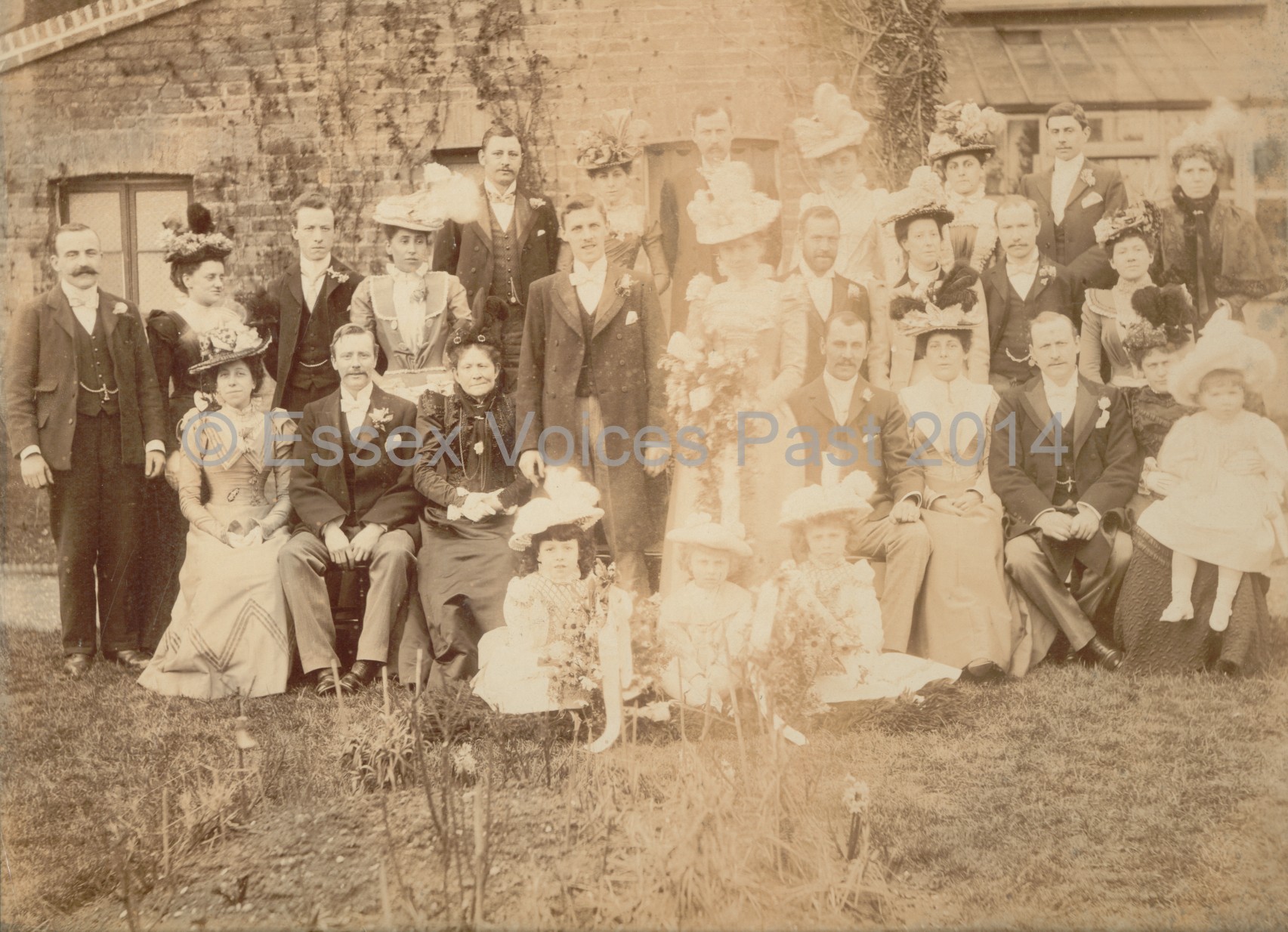
April 1899 - marriage of Lily Gurney to John Gurney. Photograph taken in the gardens of the Glengall Tavern, Peckham, South London, where John Gurney was the bar manager. This is my copy of the photograph. Barbara has a slightly different version. The fading all down the centre of the photograph - caused by strong sunshine over several years - bears testimony to the sad conclusion to this story. This photograph was not packed away in a loft or trunk somewhere out of sight and mind, but was put out on display by my grandmother, Lily's and John's daughter, who never knew her mother, except by looking at fast fading images of her. Lily did not live to see her first wedding anniversary - dying exactly 9 months after this photo was taken giving birth to her honeymoon child, my grandmother.
After this fruitful time in my research, I then moved onto history and, in 2003, signed up to do a bachelor of arts history degree with the Open University. One of the modules I did for my degree was Oxford University's Advanced Diploma in Local History. A fabulous course, which, when I did it, was nowhere near the expensive course it has now become (new funding rules in the UK have put the cost of most degree courses above the means of the average mature student). The course brought me two excellent benefits. Firstly, an appreciation and love of local history and its interconnection with family history. Secondly it introduced me to a fellow student in my cohort, the wonderful Pauleen Cass - a fellow family historian and blogger on this site, who I have had the absolute pleasure to meet in real life at our graduation in March 2006 in Oxford within the architectural splendor of the Sheldonian Theatre.
The diploma course also introduced me to something which has now become my new passion: Tudor Essex. My dissertation for the diploma was a study on the witchcraft trials of 16th Century Essex and how accusations of witchcraft came about because of neighbourly disputes. I have since expanded this research to include other "happenings" within Tudor Essex - particularly the impact of the English Reformation on small rural communities within Essex and East Anglia. To this end, I then undertook a masters degree with Cambridge University and wrote my dissertation for this degree on Religion and Society in Great Dunmow, Essex, c.1520 to c.1560 and graduated in 2012.
I have carried out so much research on Tudor Essex for my diploma's dissertation and masters' dissertation that I then decided to blog my research - the result being Essex Voices Past - which I have been writing for exactly two years this week. Shortly before Christmas of last year, my blog was spotted by a commissioning editor of a mainstream publisher of history books, Amberley Publishing, who have just commissioned me to write two local history books and a third book on the postcards of the First World War.
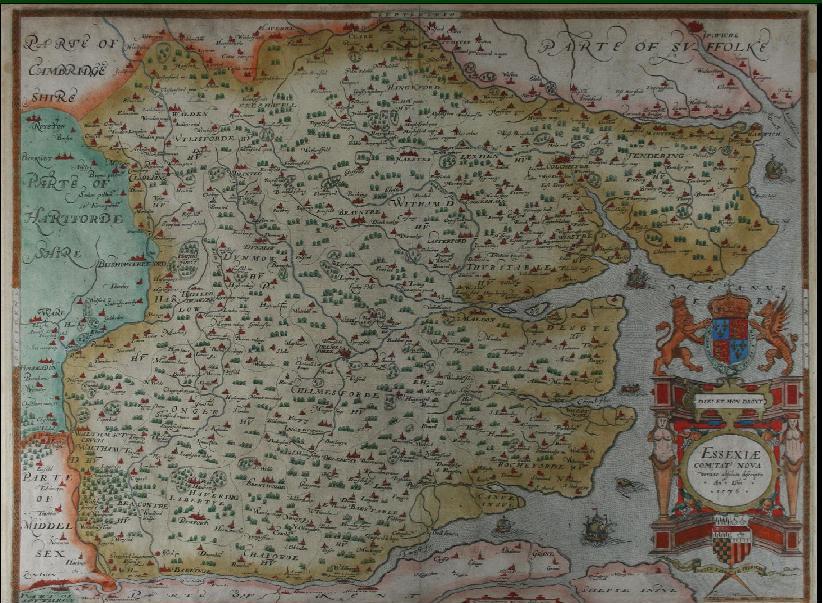
Map of Tudor Essex: Christopher Sexton, Essexiae Comitat' Nova Vera ac Absoluta Descriptio (1576). Click on the picture to be taken to the British Library's website with a detailed analysis of this map.
And that just about brings my story of my adventures of being family and local historian up-to-date. Forrest Gump once said "Mama always said life was like a box of chocolates. You never know what you're gonna get." Family and local history is also like a box of chocolates - you really never do know what you're gonna get and where you're going to end up.
I look forward to sharing with you more of my discoveries over the coming months. In the meantime, you can catch me on my blog Essex Voices Past or on twitter @EssexVoicesPast
© Essex Voices Past 2014
Kate a wonderful first post. I have been a fan of your blog for sometime following a mention from Pauleen. I remember those weight lifting moments at St Cath's lifting those books to search for the references for various ancestors. Reading your post brought back some great memories of the early days of my research in the mid 1980's. As to my dissertation, mine was a bit different and focused on Newfoundland and Devon migration purely because of the geography of getting to Surrey was at the time problematic. One day I might dust it off and do something with it. In the meantime, I am working like you on a book although for a different publisher.
ReplyDeleteThank you Julie. Researching back in the '80s was good fun, wasn't it! I recall long days of researching, followed by an anxious wait for the post to bring the (hopefully) right certificates and then manually piecing it all together with good ole manual index cards... Although perhaps that's through rose-tinted glasses - much easier these days with the internet - and I don't think that these days I'm physically up to weight lifting those books!
DeleteGood luck with your book.
Oh Kate! I love your post. I loved how you used Forrest Gumps mother's famous saying! It is so true! I also appreciate your academic skills in writing this post, something I can aspire to...It is clear you are a trained historian.
ReplyDeleteThe fact that you mention 1st cousins marrying each other and not being in some back woods somewhere also breaks the myth of where it happens. Thank you for sharing about your Great Grandmother Lily. Very sad. I look forward to your next posts.
Thank you Yvette.
DeleteI've always found it strange that 1st cousins marrying in Victorian London didn't seem to have been a problem for the family. Lily's older sister, Clara, had married John's older brother, George, ten years previously (so also 1st cousins) and no one minded (they are in the photo but I'm not sure which couple they are). The photo itself also shows that it was accepted as all the siblings are there and the bride's mother is also present (the old lady sitting next to the groom).
Lily's story and the tragedy of her early death has always moved me the most out of all my ancestors-hunting because it meant my grandmother had a very painful childhood at the hands of her wicked step-mother.
Amberley made a good choice. Delightful post, Kate.
ReplyDeleteThank you.
DeleteHi Kate, loved your post! Great intro. It is so exciting to read about everyone's family tree adventures. All so different and interesting.
ReplyDeleteDi
Thank you. Yes, it's fascinating reading each others' posts.
Deletehi Kate, great to hear your story in a different forum. Like you & Julie, I remember visiting St Catherine's and doing a spot of body-building, then going to look at the census records with everything being security-scanned in the days of Irish issues. I was also quite taken that the London School of Economics was just round the corner, since my degree was Economics.
ReplyDeleteWhat a complicated family you have. I have sisters marrying brothers but no first cousins, guess there weren't too many over here. I had no idea you had East End ancestry but of course remember all about the witches! What a great day our graduation was, with all of us together in the one place. Good fun, and lots of chat...such a wonderful experience after surviving that wretched database segment that I loved so much ....not!
Look forward to more stories, and yes, the mysteries of where local and family history adventures take us all.
Cheers
Pauleen
Hi Pauleen - yep eastenders on my paternal side through and through!
ReplyDeleteAhhh - that wretched database! How many sleepness nights did that cause! My witches are about to get an outing on my blog. For the first time since I wrote it in 2005, I've re-read my dissertation and so am dusting it off, ready to publish it - watch out the Witches of Essex are on their way!
Kate
What a fascinating post and thank you for introducing me to the Dunmow Flitch - I had never heard of before - and to the history of Essex - a county I know little about. I could relate to your early research in pre-Internet days and I was particularly interested in your links with the East End of London as my husband's ancestors (mariner background) lived in Shadwell and Limehouse. I look forward to reading more.
ReplyDeleteThank Sue. Yes the Dunmow Flitch is certainly a very very strange medieval English custom. Essex always has such a bad name because of London's urban sprawl into it but it's actually a stunningly beautiful county in the north of the county with chocolate-box thatched cottages and tiny medieval villages.
ReplyDeleteMy family has come full-circle with the East End as my daughter now lives in Docklands - although in much better swanky living conditions than her ancestors!.
Wow, Kate - I've another new blogger to add to my list! Thanks for such a comprehensive post that told me lots about you but also about my blogging pal, Pauleen.
ReplyDeleteHi Jill - it's lovely to meet you! This is such an interesting project.
ReplyDeleteI love that you found such a great gene-cousin collaborator. That's how worldwide connections are made. I was fortunate enough to meet virtually a 4th cousin, who lives in New Zealand. We work on our Semple family together. Unfortunately, we haven't yet met.
ReplyDeleteThank - it's lovely meeting cousins isn't it. I've meet so many cousins on so many different lines. It was through an "internet cousin" that I found out my grandfather Cole's aunt and uncle and all their children all lived in Great Dunmow (now my home town) 90 years before I moved into the town (I previously thought I had no connection to the town whatsoever). Two of my grandfather's cousins were killed in the First World War and their names are on "my" home town's war memorial. Every year, on Remembrance Sunday, I always make sure my family pay our respects to their names. It was very strange to realise that my grandparents were very likely to have been present at the unveiling of the war memorial in the 1920s and that I really am walking the same streets as my ancestors.
ReplyDeleteTerrific introduction, your family story is fascinating, love all the graphics!
ReplyDeleteHi Kate
ReplyDeleteHave really enjoyed reading about what you are doing, seeing the family growing up and I am very impressed with your fabulous gold stitching and your Essex website.
You may not have time for Gurney genealogy, but thought you would like to know I have turned up another distant Gurney cousin living in Melbourne. Peter Gurney's g grandfather Richard Victor came to Australia and married here. Peter said he has inherited boxes/trunks of family stuff and to wet my appetite, sent me a copy of a photo of James Gurney and Martha Swain Jeary with nine of their children taken abt 1855! Peter descends from our James and John Gurney's younger brother Henry Richard. His son Richard Victor settled in Bowral in NSW and his son way Guy Gurney. Do you want me to forward any info as it come to hand? is your email still ---antiques@----serve? I plan to be in England in June so would love to catch up if we can co-ordinate a day free!
Hi Barbara - how fantastic another relative! I do remember when I was a child talk of a Victor Gurney and most certainly a Guy Gurney from Australia (the name Winnie Gurney also rings a bell - a sister of Guy's?). Something vague in my memory is that Guy Gurney came over to England during WW2 (or, more likely, afterwards) and met my grandmother.
DeleteI wonder if that photo of 1855ish was taken because James Swain and Matilda Jane were about to emigrate to Australia?
Are there any more cousins intermarrying?
Would love to hear of any new info - and any photos! Let me know when you are back in England - would be lovely to meet up again.
Best email address is thenarrator[at]essexvoicespast[.][com] (I don't use the other one anymore) Or on Facebook.
Thanks Kate for a great blog. I am Richard Victor Gurney great granddaughter. His son Guy was my Grandfather. I was just googling the Gurney name and came across your blog. Such wonderful family history. Thanks so much for sharing.
ReplyDeleteThanks Rebecca. Another cousin - nice to "meet" you! I think we must be 4th cousins?
DeleteHello Kate - My name is Marian Preston (nee Gurney) and I am just beginning to research my family history. I came across your website and blog, which I read with interest, and I realised that James Bloss Gurney is somebody that is within my own family tree - I believe he was my great grandfather. I hope this link may be of interest to you and if you would like to find out more or would like to see some of the old photos I have of the Gurney family please let me know. I actually live not too far from you, just outside Chelmsford!
ReplyDeleteBest wishes and I hope to hear from you soon.
Marian
Hi Kate
ReplyDeleteI don't know if you will remember me but we met when Barbara and ourselves shared a curry in the East End quite a few years ago now. I think the baby of the family must now be a teenager. Also how are the girls. Would love to catch up with you and share some information on the Gurneys.
Regards
Anne